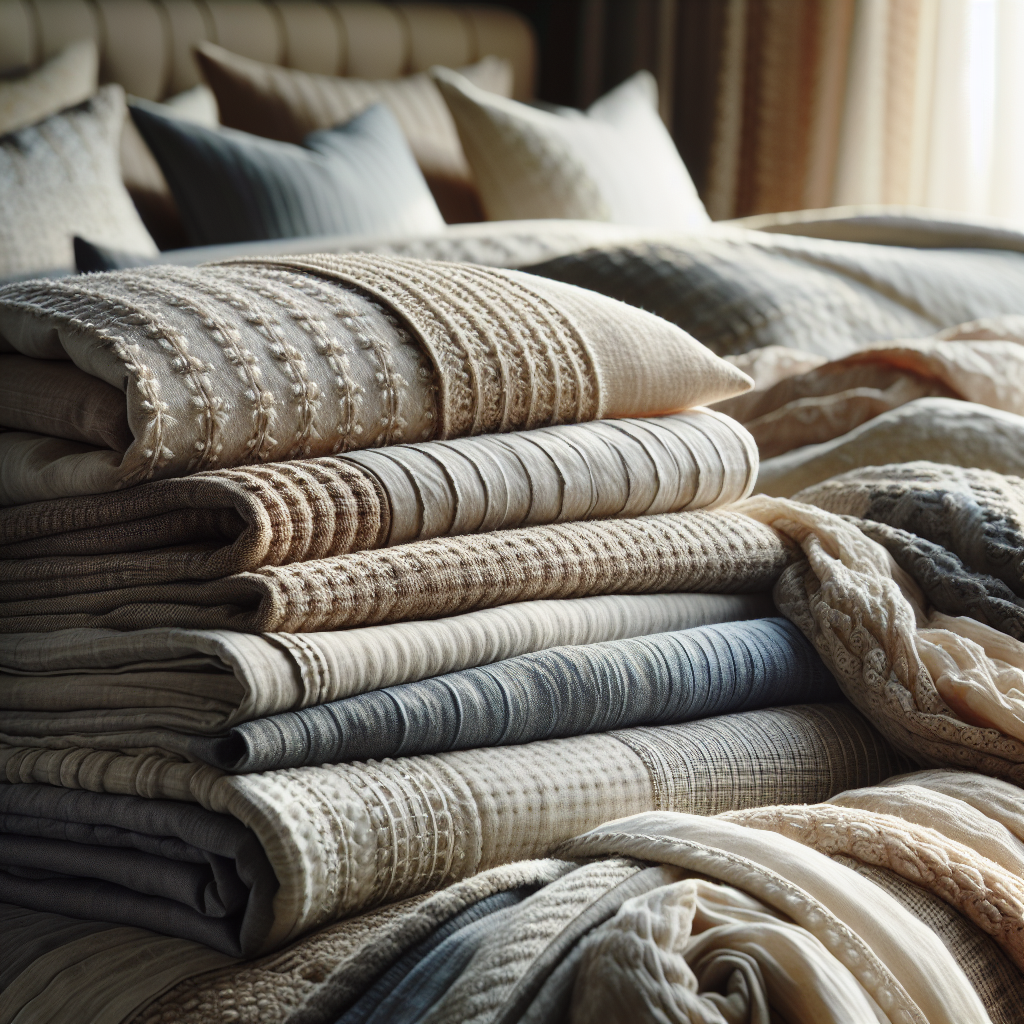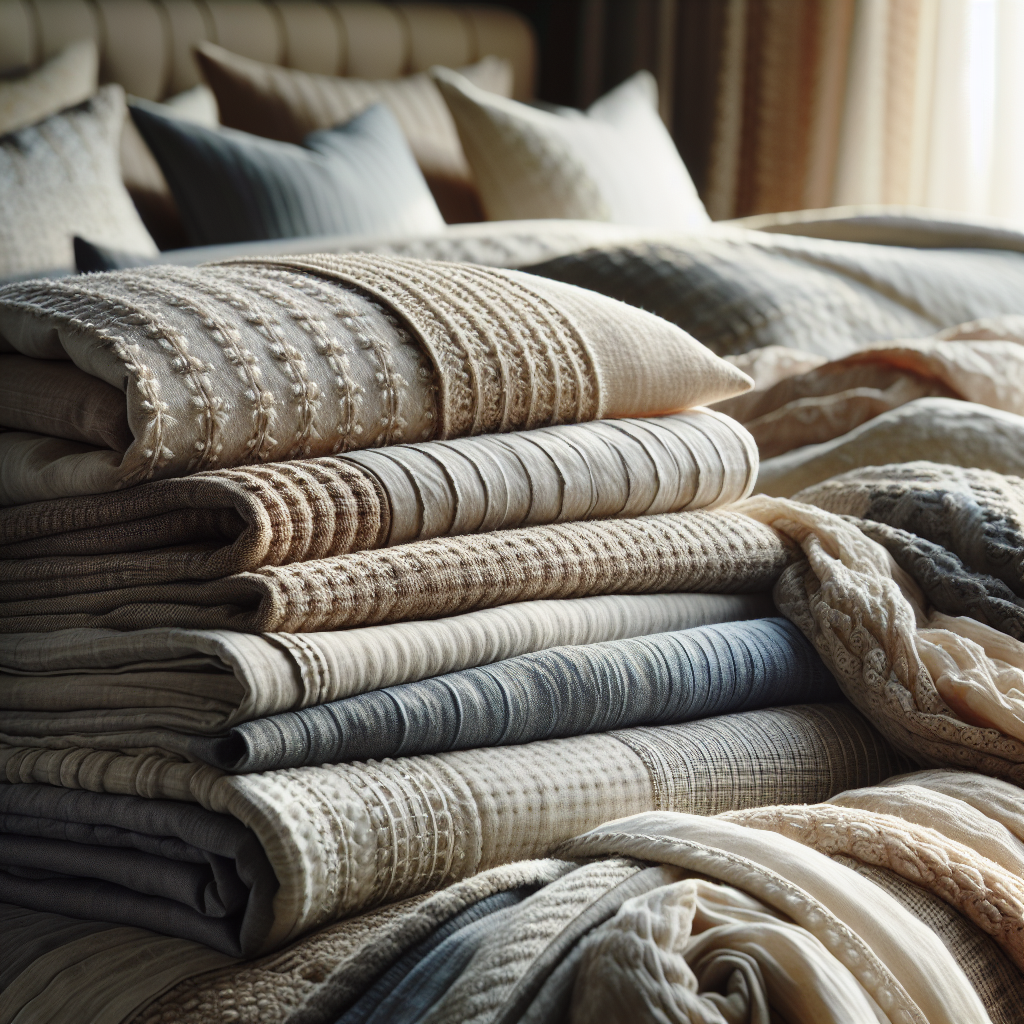When it comes to choosing the perfect bed linens, you want nothing but the best for a restful night’s sleep. But with so many options out there, how do you know which materials are truly the cream of the crop? Well, fret not, dear reader, because in this article, we’ll be exploring the world of bed linens and uncovering the top contenders when it comes to comfort, durability, and that oh-so-luxurious feel. So snuggle up, grab your cup of tea, and get ready to discover the finest materials to adorn your sleeping sanctuary. When it comes to selecting the best materials for your bed linens, there are several options to consider. Each material has its own unique benefits and characteristics, so it’s important to choose one that suits your personal preferences and needs. In this article, we’ll explore some of the most popular materials for bed linens, including cotton, linen, silk, bamboo, microfiber, flannel, satin, jersey, and Tencel, as well as a popular blend called polycotton.
Cotton
Cotton is one of the most widely used and beloved materials for bed linens. It is a natural fiber that is known for its softness, breathability, and durability. There are different types of cotton, with Egyptian cotton and Supima cotton being two of the most sought after options.
Egyptian Cotton
Egyptian cotton is renowned for its luxurious feel and exceptional quality. It is grown in the Nile River Valley and is known for its long-staple fibers, which result in a soft and durable fabric. Egyptian cotton bed linens are often considered a symbol of luxury and are prized for their comfort and breathability.
Supima Cotton
Supima cotton is another top choice for bed linens. It is made from long-staple fibers that are grown exclusively in the United States. Supima cotton is known for its strength and softness, making it an excellent option for those seeking comfort and durability in their bed linens.
Organic Cotton
For individuals who prioritize sustainability and environmental friendliness, organic cotton is a great option. It is grown without the use of harmful chemicals and pesticides, making it better for both your health and the planet. Organic cotton bed linens offer a soft and natural feel, ensuring a comfortable and eco-friendly sleep experience.
Linen
Linen is a natural fiber made from the flax plant. It has been used for centuries and is valued for its coolness and breathability, making it an ideal choice for warm climates. Flax linen and Belgian linen are two popular types of linen used in bed linens.
Flax Linen
Flax linen is made from the highest quality flax fibers, resulting in a fabric that is durable and resistant to pilling. Flax linen bed linens have a distinctive texture and offer excellent moisture-wicking properties, ensuring a cool and comfortable night’s sleep.
Belgian Linen
Belgian linen is considered the gold standard in linen production. It is made from flax fibers that are grown in Belgium and woven by skilled artisans. Belgian linen bed linens are known for their exceptional quality, softness, and luxurious feel. They are highly breathable and regulate body temperature, making them a popular choice for those who desire a restful sleep environment.
European Linen
European linen represents a broader category that includes linens made in various European countries. It embodies the same qualities as flax linen and Belgian linen, including breathability, durability, and a natural feel. European linen bed linens are often highly regarded for their quality craftsmanship and timeless elegance.

Silk
Silk is a natural fiber derived from the cocoons of silkworms. It is widely regarded as one of the most luxurious materials for bed linens, thanks to its smooth and lustrous texture. Mulberry silk and Tussah silk are the two main types of silk used in bed linens.
Mulberry Silk
Mulberry silk is considered the highest quality silk available. It is produced by silkworms that are fed exclusively on mulberry leaves, resulting in silk with long and uniform fibers. Mulberry silk bed linens are incredibly soft, hypoallergenic, and offer excellent temperature regulation.
Tussah Silk
Tussah silk, also known as wild silk, is produced by silkworms that feed on various types of leaves and not just mulberry leaves. This gives Tussah silk a richer and more textured appearance compared to mulberry silk. Tussah silk bed linens are highly valued for their unique and natural look, as well as their durability and thermal properties.
Bamboo
Bamboo is a sustainable and eco-friendly material that has gained popularity in the textile industry. It is naturally hypoallergenic, moisture-wicking, and has antimicrobial properties. Bamboo viscose and bamboo lyocell are two common types of bamboo used in bed linens.
Bamboo Viscose
Bamboo viscose, also known as bamboo rayon, is made by chemically processing bamboo fibers. Bed linens made from bamboo viscose are incredibly soft, silky, and have excellent moisture-wicking capabilities. They are a popular choice for those seeking bed linens that are gentle on the skin and provide a luxurious sleeping experience.
Bamboo Lyocell
Bamboo lyocell is another type of bamboo-based fabric that is produced using an environmentally friendly manufacturing process. It is exceptionally soft, breathable, and has excellent moisture management properties. Bamboo lyocell bed linens offer a cool and comfortable sleep environment, making them a preferred choice during hot summer months.

Microfiber
Microfiber is a synthetic material made from extremely fine fibers. It is known for its exceptional softness, wrinkle resistance, and durability. Polyester microfiber and nylon microfiber are two popular types of microfiber used in bed linens.
Polyester Microfiber
Polyester microfiber bed linens are affordable, easy to care for, and resistant to stains and wrinkles. They offer a soft and smooth feel, making them a great option for those who prioritize convenience and budget-friendly choices.
Nylon Microfiber
Nylon microfiber bed linens are known for their strength, durability, and breathability. They are highly resistant to wear and tear and provide a soft and luxurious feel. Nylon microfiber bed linens are a good choice for those seeking durable and long-lasting bedding.
Flannel
Flannel is a fabric that is known for its warmth and coziness. It is typically made from cotton or wool fibers that have been brushed to create a soft and fuzzy texture. Cotton flannel and wool flannel are the two main types of flannel used in bed linens.
Cotton Flannel
Cotton flannel bed linens are soft, warm, and perfect for colder seasons. They offer excellent insulation and provide a cozy and comfortable sleep environment. Cotton flannel bed linens are often sought after for their softness and ability to keep you warm during chilly nights.
Wool Flannel
Wool flannel bed linens, as the name suggests, are made from wool fibers. Wool is a natural insulator that helps regulate body temperature, making wool flannel bed linens suitable for colder climates. Wool flannel linens offer exceptional warmth and are known for their durability and ability to wick away moisture.

Satin
Satin is a sleek and shiny fabric that is often associated with elegance and luxury. It can be made from various materials, including polyester and silk. Polyester satin and silk satin are two common types of satin used in bed linens.
Polyester Satin
Polyester satin bed linens offer a luxurious look and feel at an affordable price. They have a smooth and shiny appearance, similar to silk satin, but with added durability and resistance to wrinkles. Polyester satin bed linens provide a touch of elegance to any bedroom decor.
Silk Satin
Silk satin bed linens are the epitome of luxury. They are made from 100% silk fibers, giving them a sumptuous feel and a natural sheen. Silk satin bed linens are known for their softness, hypoallergenic properties, and ability to regulate temperature, ensuring a comfortable and opulent sleep experience.
Jersey
Jersey is a type of knit fabric that is known for its stretchiness and softness. It is typically made from cotton or a blend of cotton and synthetic fibers. Cotton jersey and modal jersey are two popular types of jersey used in bed linens.
Cotton Jersey
Cotton jersey bed linens are breathable, lightweight, and have a soft and cozy feel. They offer excellent moisture absorption and are ideal for individuals with sensitive skin. Cotton jersey bed linens provide a relaxed and comfortable sleep environment.
Modal Jersey
Modal jersey bed linens are made from a blend of modal and cotton fibers. Modal is a semi-synthetic fiber derived from beech trees and is known for its silky texture and excellent moisture-wicking capabilities. Modal jersey bed linens offer a luxurious feel and a cool and comfortable sleep experience.

Tencel
Tencel is a sustainably produced fabric made from cellulose fibers derived from wood pulp. It is known for its softness, breathability, and eco-friendly production process. Tencel Lyocell and Tencel Modal are two popular types of Tencel used in bed linens.
Tencel Lyocell
Tencel Lyocell bed linens are soft, smooth, and have excellent moisture absorption properties. They provide a natural coolness and are hypoallergenic, making them suitable for individuals with allergies or sensitive skin. Tencel Lyocell bed linens offer a luxurious and sustainable sleep experience.
Tencel Modal
Tencel Modal bed linens have a luxurious feel and drape beautifully. They are incredibly soft and breathable, offering a comfortable and cozy sleep environment. Tencel Modal bed linens are highly sought after for their sustainability, moisture management, and resistance to wrinkles.
Polycotton
Polycotton is a blend of polyester and cotton fibers, combining the best properties of both materials. It offers the softness and breathability of cotton, along with the wrinkle resistance and durability of polyester. Polycotton bed linens are easy to care for, affordable, and provide a comfortable and versatile sleeping experience.
In conclusion, the best material for bed linens ultimately depends on your personal preferences and needs. Whether you prioritize softness, breathability, sustainability, or durability, there is a wide range of options available to suit your taste. From luxurious silk and Egyptian cotton to eco-friendly bamboo and Tencel, each material offers its own unique qualities to enhance your sleep experience. Consider the characteristics and benefits of each material as you make your decision, and you’ll be well on your way to selecting the perfect bed linens for a restful night’s sleep.





